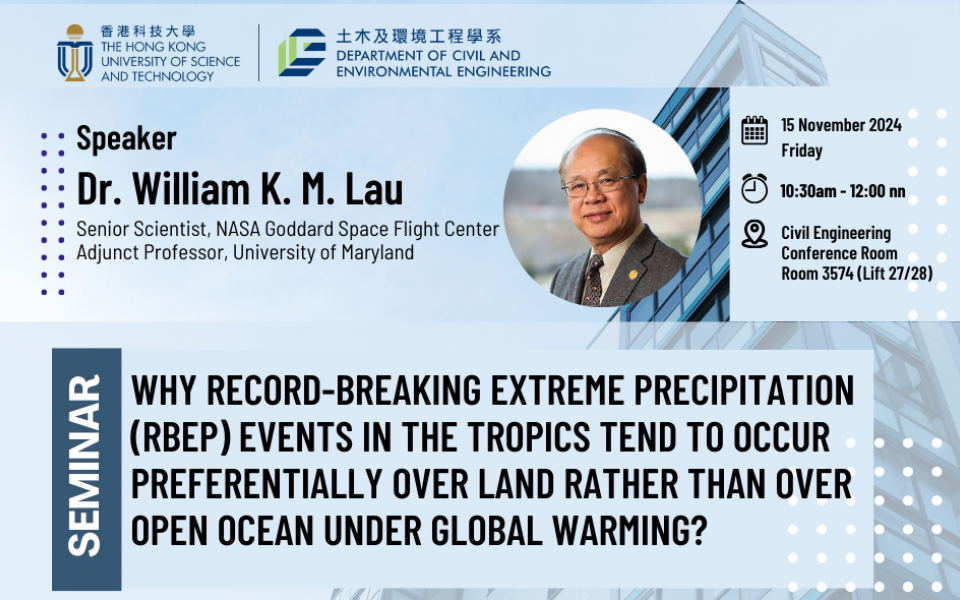Civil Engineering Departmental Seminar - Why Record-Breaking Extreme Precipitation (RBEP) Events in the Tropics Tend to Occur preferentially over Land rather than over Open Ocean under Global Warming?
Supporting the below United Nations Sustainable Development Goals:支持以下聯合國可持續發展目標:支持以下联合国可持续发展目标:
Why Record-Breaking Extreme Precipitation (RBEP) Events in the Tropics Tend to Occur preferentially over Land rather than over Open Ocean under Global Warming?
In this study, we investigate the changing characteristics of climatic-scale (monthly) tropical extreme precipitation in idealized warming climates using the DOE Energy Exascale Earth System Model (E3SM). Based on AMIP-type simulations. We found that as the surface warms under: a) uniform 4K global rise, and b) 4xCO2 induced global SSTA forcing, very extreme precipitation (VEP, defined by top 0.1% rain rate) and record-breaking-extreme-precipitation (RBEP, defined by top 0.01% rain rate) events, occur preferentially over land rather than open ocean, more severe under 4xCO2 than P4K. Overall, VEP and RBEP events are facilitated by increased precipitation efficiency, accelerated rates of recycling of precipitable liquid and ice cloud water in regions with extended anvil clouds. Changes in the vertical profiles of clouds, condensation heating, and vertical motions indicate increasing precipitation–cloud–circulation organization associated with development of Mesoscale-Convective-Systems (MCS) leading to VEP and RBEP more so over tropical monsoon land regions rather than open ocean.
Analyses of the vertical profile of moist static energy (CpT+Lq+gz) budget show that enhanced surface relative humidity (increased Lq) associated with warmer SST is the key driver of frequent heavy precipitation over tropical oceans. In contrast, a substantial reduction in land surface relative humidity, due to extended severe land warming and drying, preceding VEP and RBEP are found under P4K and more so under 4xCO2. The excessive land drying suppresses deep convection onset, i.e., enhanced convective inhibition (CIN) over land, allowing Convective Available Potential Energy (CAPE) to build up in the overlying troposphere due to advection of moist air from evaporation over ocean and/or nearby large lakes. Examination of changes in the annual cycles of P-E and surface relative humidity compared to the control indicates that preferred VEP/RBEP events over tropical land are due to SSTA induced land-atmosphere feedback, more so under 4xCO2 than P4K due to more dynamically consistent SSTA forcing in the former. Essentially, prolonged warming and drying of land surface under P4K and 4xCO2 SSTA forcing during the pre- and early rainy season suppress the development of triggering deep convection, inhibiting MCS organization needed for VEP and RBEP’s. The longer the suppression of deep convection by CIN over land, the more severe and extreme VEP/RBEP’s that eventually occur due to triggering by transient eddies, and/or orographic wind forcing, releasing extra-ordinary large amount of surplus CAPE that built up and stored in the troposphere during CIN.
William K. M. Lau received his B. Sc. (Mathematics and Physics) in 1972, and B. Sc. Special (Applied Mathematics) in 1973 from University of Hong Kong, his PhD in Atmospheric Sciences in 1978, from the University of Washington, Seattle, Washington, U.S. He was assistant professor at the Naval Postgraduate School (1978-1980) before joining the NASA Goddard Space Flight Center (GSFC) in 1981. He served as the Head of the Climate and Radiation Branch (1991-2000), Chief, the Laboratory for Atmospheres (2001-2010), and the Deputy Director for Science, Earth Science Division, NASA/GSFC (2011-2014). Currently, he is a senior scientist at the Earth System Science Interdisciplinary Center (ESSIC), and adjunct professor of the Department of Atmospheric and Oceanic Sciences, University of Maryland. Dr Lau’s research spans over 4 decades covering a wide range of topics in climate dynamics, tropical and monsoon meteorology, ocean-atmosphere interaction, aerosol-water cycle interaction, climate variability and change. Throughout the years, Dr. Lau has frequently visited international research and academic institutions in China, India, Southeast Asia, North and South America, and Europe presenting invited lectures, and keynote speeches in scientific meetings to promote research collaboration and awareness in regional impacts of climate variability and change. For further details, see https://en.wikipedia.org/wiki/William_Ka_Ming_Lau
